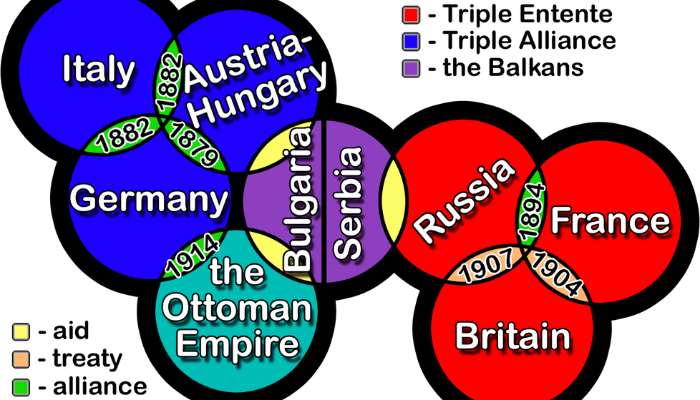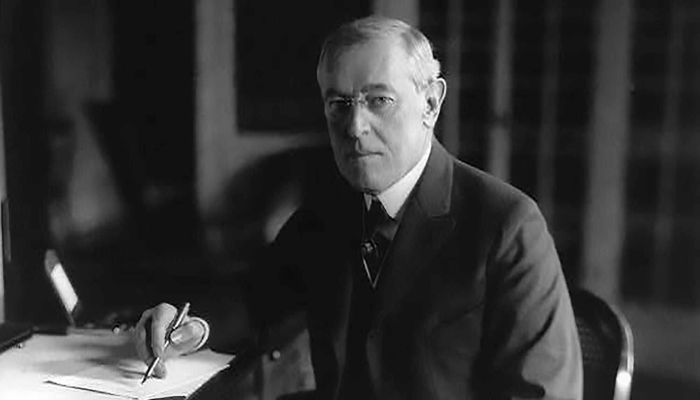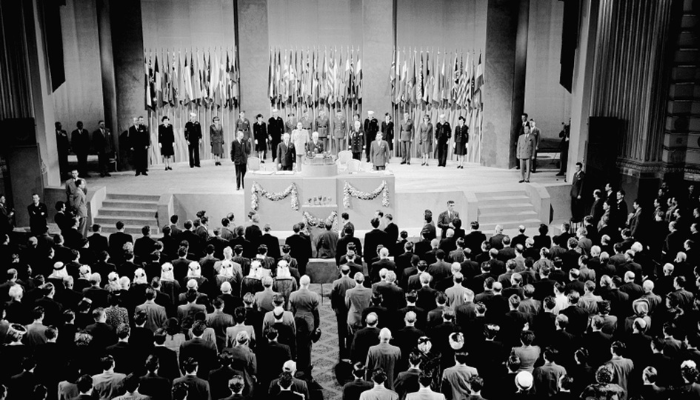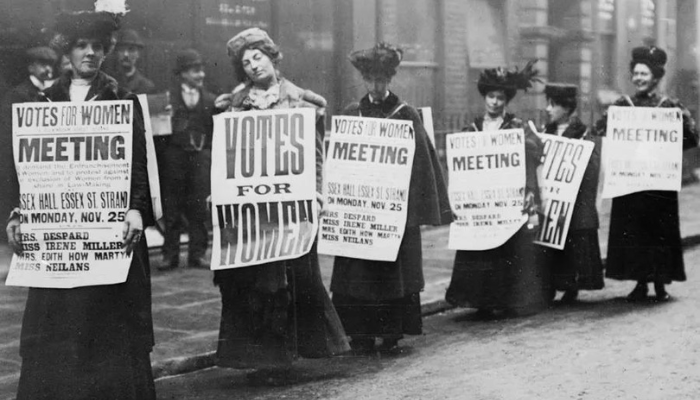Introduction to World War I
Imagine a world where countries are competing for power, and tensions are rising across Europe. Then, suddenly, in the summer of 1914, a single event triggers a war that spreads across the globe. This war, known as World War I, changed the world forever.
World War I lasted from 1914 to 1918 and is often referred to as The Great War. It was unlike anything the world had ever seen. Countries from all over the world got involved, making it one of the most destructive and far-reaching conflicts in human history. It wasn’t just soldiers on the battlefield; millions of civilians were affected too.
So, how did it all begin? It wasn’t just one cause, but a series of tensions and conflicts that had been building for years. Europe was a powder keg, and when the Archduke of Austria was executed, that spark set off a chain of events that led to war. Over 30 nations would be dragged into the conflict, including Germany, France, Russia, Britain, and eventually the United States.

This war wasn’t fought with swords or horses, but with modern weapons like machine guns, tanks, and airplanes. It marked a shift in how wars were fought and how brutal they could be. With trench warfare, where soldiers lived in muddy, cramped conditions, the suffering was immense, and many battles lasted for months.
By the time the war ended in 1918, the world was forever changed. Empires had fallen, borders had shifted, and the way countries interacted with each other was no longer the same. World War I set the stage for many of the global conflicts that followed, making it one of the most significant events in modern history.
Causes of World War I
To truly understand why World War I happened, we need to look at the deeper causes that had been building up for years. It wasn’t just a single event that sparked this massive conflict; it was a combination of factors that had been brewing for decades. Let’s explore these causes step by step.
1. Nationalism
At the heart of World War I was nationalism,

the belief that your country is superior to others. By the early 20th century, Europe was a continent filled with competing nations, each with a strong sense of pride and identity. Countries like Germany, France, Russia, and Austria-Hungary were eager to prove their power and dominance. This created a lot of tension, as each nation wanted to expand its influence and territory.
2. Imperialism
Another major cause of the war was imperialism. European powers were competing for colonies around the world, particularly in Africa and Asia.

Countries like Britain and France had large empires, while Germany and Italy were trying to catch up. This race for colonies created jealousy and conflict, as nations fought for control over new territories and resources.
3. Militarism
In the years leading up to the war, many countries were building up their militaries. This idea, known as militarism, was the belief that a strong military would solve political problems.

Nations were stockpiling weapons and training large armies, making Europe a very dangerous place. Countries like Germany and Britain were competing to have the largest and most powerful navy, which further increased tensions.
4. Alliances
Perhaps the most important cause of the war was the system of alliances. Many European nations had formed partnerships, promising to defend each other in case of an attack. For example, Germany, Austria-Hungary, and Italy were part of the Triple Alliance, while France, Russia, and Britain formed the Triple Entente.

These alliances meant that if one country went to war, its allies would follow, quickly turning a small conflict into a global war.
5. Murder of Archduke Franz Ferdinand
Finally, the spark that catch fire the war was the murder of Archduke Franz Ferdinand of Austria-Hungary on June 28, 1914.

He was killed by a Serbian nationalist in Sarajevo, and this event triggered a series of declarations of war. Austria-Hungary declared war on Serbia, and soon, their allies were pulled into the conflict.
By examining these causes, we see how a combination of nationalism, imperialism, militarism, and alliances created the perfect conditions for war. It was like a ticking time bomb waiting to explode, and the murder of the Archduke was the spark that set it off.
Countries Involved in World War I
World War I wasn’t just a European conflict; it quickly became a global war that involved countries from across the world. As alliances were triggered and nations declared war on each other, countries from Europe, Asia, Africa, and beyond were drawn into the fight. Let’s break down the major players and how they became involved.
1. The Allied Powers
The Allied Powers were the nations that came together to oppose the Central Powers. They were mostly European countries, but others from across the world joined as well. Some of the key Allied Powers were:

- France: France was a major force in World War I and fought extensively on the Western Front against Germany. They had long-standing tensions with Germany, especially after losing the Franco-Prussian War in 1871.
- Britain: As a global empire with colonies around the world, Britain brought its military might, as well as soldiers from its colonies, into the war. British troops fought mainly in Europe but also in the Middle East and Africa.
- Russia: As part of the Triple Entente, Russia was one of the first to enter the war in support of Serbia. However, due to internal struggles and the Russian Revolution in 1917, they withdrew before the war ended.
- Italy: Though initially part of the Triple Alliance with Germany and Austria-Hungary, Italy switched sides in 1915 and joined the Allied Powers, seeking territorial gains at Austria-Hungary’s expense.
- The United States: The U.S. initially stayed neutral, but joined the Allies in 1917 after repeated attacks on American ships by German submarines and the revelation of the Zimmermann Telegram, in which Germany tried to incite Mexico to attack the U.S.
2. The Central Powers
The Central Powers were the nations fighting against the Allies. The primary members were:

- Germany: As one of the most powerful and militarized countries in Europe, Germany was a key player in the war. They supported Austria-Hungary and faced battles on both the Western Front (against France and Britain) and the Eastern Front (against Russia).
- Austria-Hungary: The murder of Archduke Franz Ferdinand was the event that pulled Austria-Hungary into the war. They were directly involved in the fighting in the Balkans, particularly against Serbia and Russia.
- Ottoman Empire: The Ottoman Empire joined the Central Powers in 1914. Its involvement led to significant fighting in the Middle East, including the Gallipoli Campaign, where the Allies tried to knock the Ottomans out of the war.
- Bulgaria: Bulgaria entered the war in 1915 on the side of the Central Powers, motivated by territorial disputes in the Balkans. Their army fought mainly in the Balkans against Serbia, Greece, and Romania.
3. Other Countries Affected

- Canada, Australia, India, and other colonies under British rule contributed significantly to the war effort, sending soldiers to fight in Europe and the Middle East.
- Japan joined the war in 1914 as part of its alliance with Britain, focusing on taking over German-held territories in Asia and the Pacific.
- China: Though not a fighter, China supported the Allies and sent laborers to the frontlines in Europe to help with logistics.
In total, more than 30 countries were involved in World War I, either through direct military action or by providing support. This truly was a global conflict, with battles stretching across Europe, Africa, Asia, and the Middle East. The vast number of nations drawn into the war reflects how interconnected the world had become by the early 20th century.
Key Players in World War I
World War I involved many countries, but some emerged as the most significant contributors to the war effort, both on the battlefield and in shaping its outcomes. These key players influenced the direction of the war and played vital roles in both military and diplomatic strategies. Let’s take a closer look at these central nations and their actions.
1. Germany: The Driving Force of the Central Powers

- Germany was perhaps the most powerful and aggressive member of the Central Powers. Under the leadership of Kaiser Wilhelm II, Germany had been preparing for war for years, building up a strong military force and forming alliances with Austria-Hungary and Italy.

- Germany’s occupation of Belgium and France through the Schlieffen Plan was one of the war’s early defining moments. They wanted to quickly defeat France before turning their attention to Russia in the east, but their plan was unsuccessful, leading to a prolonged war on both the Western and Eastern Fronts.

- U-boat warfare: Germany also used submarines (U-boats) to target ships in the Atlantic, including those of neutral countries like the United States, ultimately drawing America into the war.
2. France: Defending the Homeland

- France was one of the most heavily affected countries during the war, with much of the fighting on the Western Front occurring on French soil. French soldiers, known as Poilus, endured horrific conditions in the trenches, defending their homeland against German attacks.
- France, under the leadership of Georges Clemenceau, was determined to regain Alsace-Lorraine, a region lost to Germany in the Franco-Prussian War of 1871.

- French military strategies and efforts at the Battle of the Marne and the Battle of Verdun were crucial in preventing Germany from advancing further into Western Europe.
3. Britain: Defending the Empire
- Britain entered the war after Germany invaded neutral Belgium, honoring its commitment to defend Belgian neutrality. The British Empire was vast, and soldiers from across the empire, including Canada, India, Australia, and New Zealand, joined the fight.

- The British Navy played a vital role in surrounding German ports, cutting off supplies to Germany and starving the Central Powers of resources. Britain also played a major part in the Middle Eastern campaign, working with Arab forces to defeat the Ottoman Empire.
4. The United States: Turning the Tide
- Though the United States remained neutral for much of the war, its entry in 1917 was a major turning point. The Zimmermann Telegram and repeated German submarine attacks on American ships finally pushed the U.S. to declare war on Germany.

- Under the leadership of President Woodrow Wilson, the U.S. provided fresh troops, supplies, and financial support, which greatly strengthened the Allies at a time when they were exhausted from years of fighting.

- The U.S. contribution was not only military but also diplomatic. Wilson’s Fourteen Points became the basis for peace talks at the end of the war, focusing on self-determination, free trade, and the creation of the League of Nations.
5. Russia: The Eastern Giant
- Russia was one of the original members of the Allied Powers, entering the war to protect Serbia and oppose Austria-Hungary. However, due to internal unrest, Russia struggled with both military defeats and a collapsing economy.

- The Russian Revolution in 1917 led to the fall of the Tsar and the rise of the Bolsheviks, who quickly signed the Treaty of Brest-Litovsk with Germany, withdrawing Russia from the war. This shift allowed Germany to focus more on the Western Front.
6. Austria-Hungary: The Spark of the War
- Austria-Hungary, under Emperor Franz Joseph, was at the center of the war’s beginning. The murder of the Archduke Franz Ferdinand by a Serbian nationalist gave Austria-Hungary the excuse it needed to declare war on Serbia, triggering the network of alliances that pulled the rest of Europe into the conflict.

- Austria-Hungary’s military was weaker than its allies’, and the empire struggled to keep its diverse ethnic groups united during the war.
7. The Ottoman Empire: Fighting for Survival
- The Ottoman Empire joined the Central Powers in 1914, seeking to regain territory it had lost in previous wars. The Gallipoli Campaign was one of the empire’s most famous victories, where Ottoman forces, under Mustafa Kemal Atatürk, successfully repelled a major Allied invasion.

- However, by the end of the war, the Ottoman Empire was collapsing, with territories in the Middle East breaking away under the influence of Allied forces.
8. Italy: Switching Sides
- Though originally part of the Triple Alliance with Germany and Austria-Hungary, Italy switched sides in 1915, joining the Allies after being promised territorial gains.
- Italy’s role was primarily on the Italian Front, where they fought Austria-Hungary in the rugged terrain of the Alps.
These key players shaped the war in profound ways, with each country contributing to the complexity and scale of the conflict. Their decisions, alliances, and military strategies would not only determine the outcome of the war but also shape the geopolitical landscape for years to come.
Formation of the United Nations: A Response to Global Conflict
After the destruction of World War I, the world was left in shock, searching for ways to prevent such a disaster from happening again. Although the war officially ended with the Treaty of Versailles in 1919, it was clear that a more permanent solution was needed to foster peace and cooperation among nations. This realization led to the creation of the United Nations (UN), an organization formed with the hope of maintaining international peace and security. But how exactly did the United Nations come to be, and what was its purpose?
The League of Nations: The First Attempt
- Before the United Nations, there was the League of Nations, formed in 1920. This was the first international organization aimed at maintaining peace by resolving disputes between countries diplomatically.

- The idea for the League of Nations was championed by U.S. President Woodrow Wilson in his Fourteen Points, which he proposed at the end of the war. Unfortunately, the League was flawed from the start, as the United States never joined, and key nations like Germany and Japan later withdrew.
- Despite its good intentions, the League of Nations was ineffective in preventing conflicts like World War II due to its lack of enforcement power and the unwillingness of major countries to fully cooperate.
The Birth of the United Nations: Learning from Mistakes
- After World War II, leaders realized that a new, more robust organization was needed to prevent future conflicts and foster global cooperation. This led to the birth of the United Nations in 1945, replacing the League of Nations.
- Unlike the League, the United Nations was designed with a more solid structure and a Security Council that had the power to enforce decisions. The five permanent members of the Security Council—the United States, the Soviet Union (now Russia), China, France, and the United Kingdom—were given veto power, allowing them to prevent any resolution they opposed from being passed.
Why the United Nations Was Formed

- Peace and Security: The main goal of the United Nations was to ensure that nations could resolve disputes through dialogue, rather than war. The UN Charter focused on maintaining international peace and security.
- Human Rights: In the aftereffects of World War I, it was clear that international efforts needed to prioritize human rights. The horrors of the war, particularly in terms of civilian suffering, pushed leaders to make human rights a central focus of the UN.
- Development and Cooperation: The UN aimed to promote social and economic development worldwide, believing that poverty and inequality often lead to conflict. By encouraging cooperation between nations, the UN hoped to create a more stable and prosperous world.
The United Nations Today
- Since its formation, the UN has played a significant role in shaping the post-war world. The organization has taken part in peacekeeping missions, worked on reducing global poverty, and promoted human rights.
- Over time, the UN has expanded its scope to address environmental issues, climate change, and global health crises. It has become a platform for nations to work together on a wide range of global challenges, proving that peace and cooperation are possible, even after the most devastating wars.
Key UN Achievements
- The Universal Declaration of Human Rights (1948) was one of the first major accomplishments of the UN, setting standards for the treatment of individuals globally.
- The UN has played a central role in peacekeeping missions around the world, from the Middle East to Africa, deploying forces to help maintain peace in conflict zones.
The United Nations continues to evolve as it addresses new challenges, but its foundation, rooted in the lessons of World War I and the desire for lasting peace, remains as relevant as ever.
The Power Struggle and its Global Impact
- The involvement of so many major powers made World War I a truly global conflict, with battles fought in Europe, Africa, the Middle East, and even the Pacific.
- The collapse of empires (Austro-Hungarian, Ottoman, Russian) and the redrawing of national boundaries in the aftermath of the war reshaped the world in ways that are still felt today.
Each major power played a unique role in shaping the course of World War I, influencing the conflict and its eventual outcomes. The war wasn’t just a European event; it affected countries around the world and set the stage for World War II.
Impact on Global Governance
- The creation of the United Nations represented the world’s commitment to working together for the common good. This effort began in response to the devastating effects of World War I, and although it was refined after World War II, the seeds were planted as early as 1919 with the formation of the League of Nations.
- Today, the UN continues to be a central platform for global diplomacy, cooperation, and peace efforts, shaping the future of international relations and preventing global conflicts on the scale of World War I.
By understanding the United Nations and its connection to the aftereffects of World War I, we see how global politics shifted from national rivalries and military build-up to diplomacy and cooperation—a legacy that still shapes our world today.
The Lasting Effects of World War I on the Modern World
The legacy of World War I extends far beyond the battles and settlements. This global conflict reshaped the political, economic, and social landscapes of the 20th century, with many of its consequences still being felt today.
Political Changes: The Fall of Empires
- One of the most significant outcomes of World War I was the collapse of major empires. The Austro-Hungarian Empire, the Ottoman Empire, the German Empire, and the Russian Empire all fall down, giving rise to new nations and shifting global power.
- The war also covered the way for political ideologies like communism and fascism. The Russian Revolution of 1917, triggered partly by the strain of war, led to the rise of the Soviet Union, which would dominate global politics for much of the 20th century.
- In Germany, the harsh terms of the Treaty of Versailles and the economic destruction that followed contributed to the rise of Adolf Hitler and the Nazi Party, ultimately leading to World War II.

Social and Economic Changes: A New World Order
- The war caused immense economic destruction. Countries involved in the conflict, particularly those in Europe, were left in massive debt, leading to years of financial instability. This economic strain fueled social unrest and political instability in many regions.
- Women’s roles in society began to change dramatically. With millions of men fighting on the frontlines, women took on roles traditionally held by men, working in factories and offices. This shift played a key role in the women’s suffrage movement, leading to women’s voting rights in several countries.

- The war also brought about major changes in technology and industry. The demands of warfare accelerated advances in military technology, such as tanks, aircraft, and chemical weapons. After the war, many of these technologies found civilian applications, driving industrial growth.
Shifts in Global Power
- World War I marked the end of European dominance in global affairs. Prior to the war, Europe had been the center of world power, but the war weakened many European countries and shifted the balance of power.
- The United States, which had emerged relatively unscathed from the conflict, became a global economic leader. Its involvement in the war solidified its position as a key player on the world stage, a role that would only grow in the years to come.
- The war also sowed the seeds of decolonization. While European empires still controlled large parts of the world, the war weakened their grip on colonies. Nationalist movements in places like India, Africa, and the Middle East gained momentum, setting the stage for future independence struggles.
New Borders and Conflicts
- The Treaty of Versailles and other post-war agreements redrew the map of Europe and the Middle East, creating new nations and borders. However, many of these borders were drawn without regard to ethnic or religious divisions, leading to future conflicts.
- For example, the division of the Ottoman Empire led to the creation of modern states like Iraq, Syria, and Palestine, but these new borders fueled tensions that still continue today.
The Psychological Impact
- The trauma of World War I deeply affected those who survived. Known as the “Lost Generation,” many soldiers returned home with physical and emotional scars, struggling to reintegrate into society. The horrors of trench warfare and the use of new weapons like poison gas left a lasting imprint on the collective psyche.
- This sense of disillusionment was reflected in the art, literature, and culture of the time, with writers like Ernest Hemingway and T.S. Eliot capturing the despair and uncertainty of a post-war world.
World War I’s Legacy of Global Conflict
- The unresolved tensions from World War I laid the groundwork for future conflicts. Many historians see the war as the first chapter in a “long 20th century” of conflict, lead up to in World War II just two decades later.
- The war also set a precedent for modern warfare, with the large-scale use of technology, propaganda, and global alliances. These elements would play a crucial role in the conflicts that followed, from World War II to the Cold War and beyond.
Influence on International Law
- One of the positive legacies of World War I was the development of international law. The war crimes committed during the conflict, including the mistreatment of civilians and prisoners of war, moved the creation of rules to govern wartime behavior. The Geneva Conventions were expanded in the aftermath of the war, laying the foundation for international humanitarian law.

A World Forever Changed
- The impact of World War I on the modern world is undeniable. From the rise and fall of empires to the reshaping of global politics and the birth of new nations, the war left a mark on every aspect of life.
- The conflict set in motion events that would define the 20th century and beyond, influencing everything from the formation of the United Nations to the current political landscape.
- As we reflect on the war’s legacy, it’s clear that World War I not only changed the course of history but also changed the very fabric of the world we live in today.

